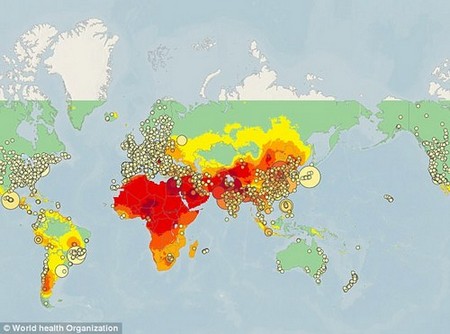The WHO report revealed every corner of the globe is dealing with air pollution – but poorer countries fare worse, with outdoor pollution levels highest in the Middle East, North Africa and South-East Asia.
More than 90 per cent of the world are breathing in polluted air, health chiefs warn.
The World Health Organization yesterday released the results of its study into fine particle air pollution in nearly 110 countries. These microscopic particles are invisible to the human eye – but can penetrate deep into the lungs, and also cause heart disease and cancer.
The UN body yesterday blamed air pollution for at least seven million deaths each year, while campaigners urged for more action from Governments. Find out how your city rates for air pollution below
Dr Tedros Adhanom, chief of the WHO, said: ‘Air pollution threatens us all, but the poorest and most marginalised people bear the brunt of the burden.’ There are no safe levels of exposure to PM2.5, which includes toxins like sulfate and black carbon, and pose the greatest risk to human health.
Major sources of air pollution from particulate matter include the inefficient use of energy by households, industry, the agriculture and transport sectors, and coal-fired power plants.
What was the report?
The WHO report collected PM2.5 and PM10 data from around 4,300 cities across nearly 110 countries. It revealed nine out of 10 people are exposed to levels of air pollution that are dangerous to their health.
This was from toxins outdoors or in their own homes, where in poor countries many have inefficient cook stoves or kerosene lamps.

The WHO report revealed every corner of the globe is dealing with air pollution – but poorer countries fare worse
They warned three billion people across the world still don’t have access to clean cooking fuels and technologies in their homes.
A dramatic problem
Maria Neira, head of the WHO’s department of public health and environment, said: ‘This is a very dramatic problem we are facing.’ The use of dirty cooking fuel, like burning charcoal, is estimated to cause some 3.8 million premature deaths each year.
Dr Tedros branded the findings ‘unacceptable’. Outdoor air pollution levels were highest in the Middle East, North Africa and in South-East Asia, the WHO said.
In these regions, air pollutants are often found at levels more than five times higher than what is considered safe. Outdoor air pollution was linked to 4.2 million fatalities annually. In around one million of those cases, a combination of indoor and outdoor pollution was to blame.

Pollution levels of fine particle air pollution known as PM2.5 are reaching above limits in 49 places in the UK, the WHO study has found
Around 90 per cent of deaths linked to air pollution occur in middle income and developing countries, the report said.
Findings in the UK
The WHO study found that 49 towns and cities in the UK levels of fine particle air pollution above recommended limits. This included 31 which had levels of PM 2.5 that are considered above safe limits.
Larger cities such as London, Manchester and Nottingham are breaching standards, as well as smaller towns including Prestonpans, near Edinburgh. The most polluted place in the UK, according to the survey, was Port Talbot in Wales, which had nearly double the safe limit of PM2.5.
A need for further research
Professor Gavin Shaddick, from the University of Exeter, led the international team behind the WHO report. He said air pollution ‘presents a major risk to health worldwide’. Jenny Bates, of Friends of the Earth, said the study ‘demonstrates the need for further research, for us to properly understand and improve the state of air pollution across the UK’.
Professor Kevin McConway, emeritus professor of applied statistics at the Open University, said while there was a need to take action on air pollution in richer cities such as London, the problem was far greater in other parts of the world.
‘We must not be complacent about UK air pollution, but in global terms, things really aren’t at all bad here,’ he said.
Port Talbot: The most polluted place listed in the survey is a town in Wales with a population of 37,000. It is best known as the home of the Port Talbot Steelworks, one of biggest steelworks in the world
WHAT WERE THE CITIES IN THE UK THAT BREACHED SAFE AIR POLLUTION LIMITS?
Port Talbot: 18 mg per cubic metreScunthorpe: 15
Salford: 15
Gibraltar: 14
Thurrock: 14
Manchester: 13
Swansea: 13
Gillingham: 13
Carlisle: 12
Chepstow: 12
Leeds: 12
Leicester: 12
Liverpool: 12
Grays: 12
Eccles: 12
Nottingham: 12
Plymouth: 12
York: 12
Prestonpans: 12
Royal Leamington Spa: 12
Sandy: 12
Sheffield: 12
Stoke-On-Trent: 12
London:11
Coventry: 11
Hull: 11
Londonderry: 11
Middlesbrough: 11
Norwich: 11
Southend-On-Sea: 11
Stockton-On-Tees: 11
Storrington: 11
Wigan: 11
But clean air campaigners called for the UK Government, which has faced legal action over its failure to meet legal targets on another air pollutant nitrogen dioxide, to take steps to stop people breathing dirty air.
Demands for a new law
Environmental law charity ClientEarth chief executive James Thornton said: ‘These new statistics show a worrying level of this dangerous air pollution across the country.
‘People shouldn’t have to breathe air on a daily basis which the WHO deems unhealthy.
‘A new Clean Air Act would protect our right to breathe clean air and drive greater ambition to meet safer WHO guideline levels.
‘Ministers should commit to this now. Without it, many people across the UK will continue to pay with their health.’
Alison Cook, director of policy at the British Lung Foundation, said: ‘This report reconfirms that air pollution is one of the leading environmental public health crises in the UK today.
‘Action to reduce the toxic particles in the air we breathe can no longer be delayed.
‘How much more evidence do we need to see before the Government sets new legal limits on pollution levels to protect the nation’s lung health?’
A Defra spokesman said: ‘While air quality in the UK has improved significantly since 2010, this report from the WHO clearly shows the impact air pollution is having on the health of men women and children in the UK and across the world.
‘Tackling this important issue is a priority for this government which is why we have a £3.5 billion plan to improve air quality and reduce harmful emissions and will set out further actions through a comprehensive Clean Air Strategy later this year.’
More monitoring needed
More than 1,000 new cities were added to the WHO’s report since its last one, released two years ago. The body noted that monitoring can prompt action towards addressing the problem.
However, only eight of 47 countries in Africa gave air quality information about one or more of their cities. And the database only listed information on nine Chinese cities.



